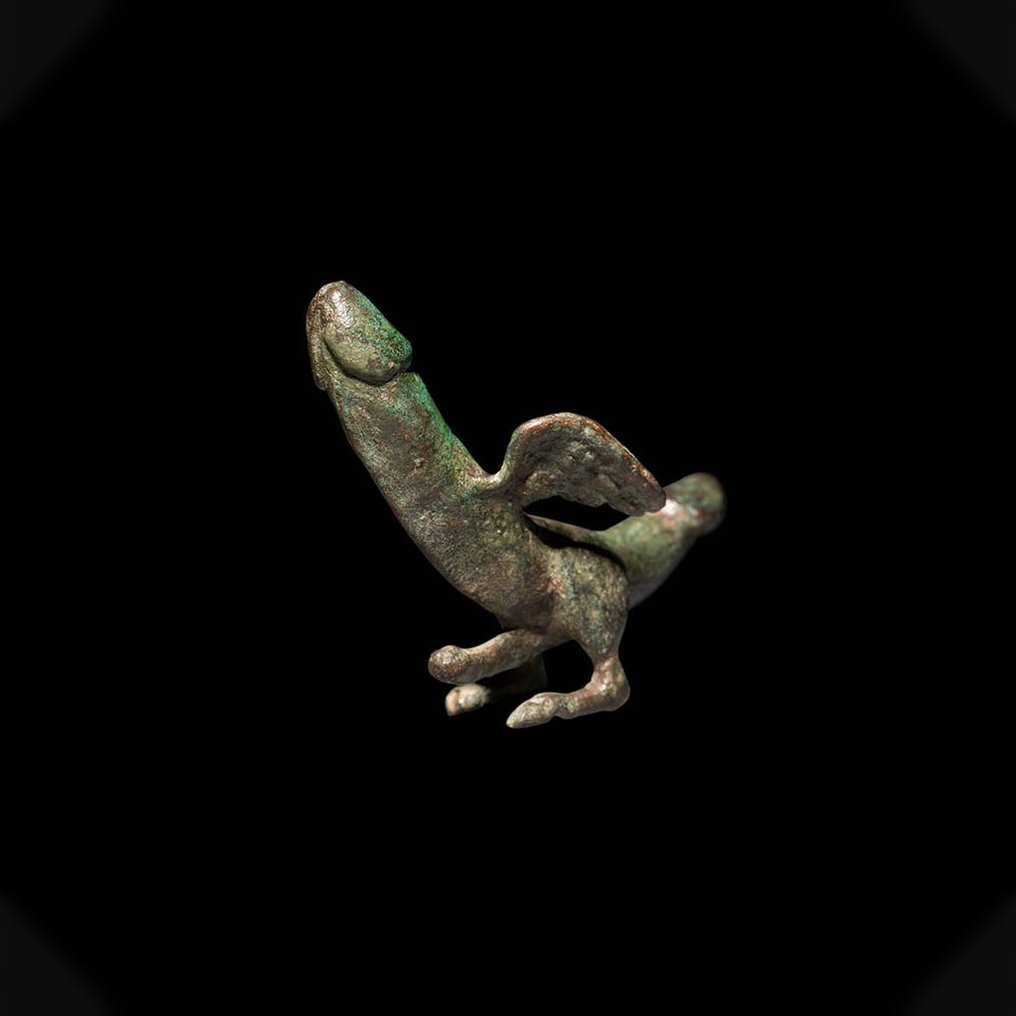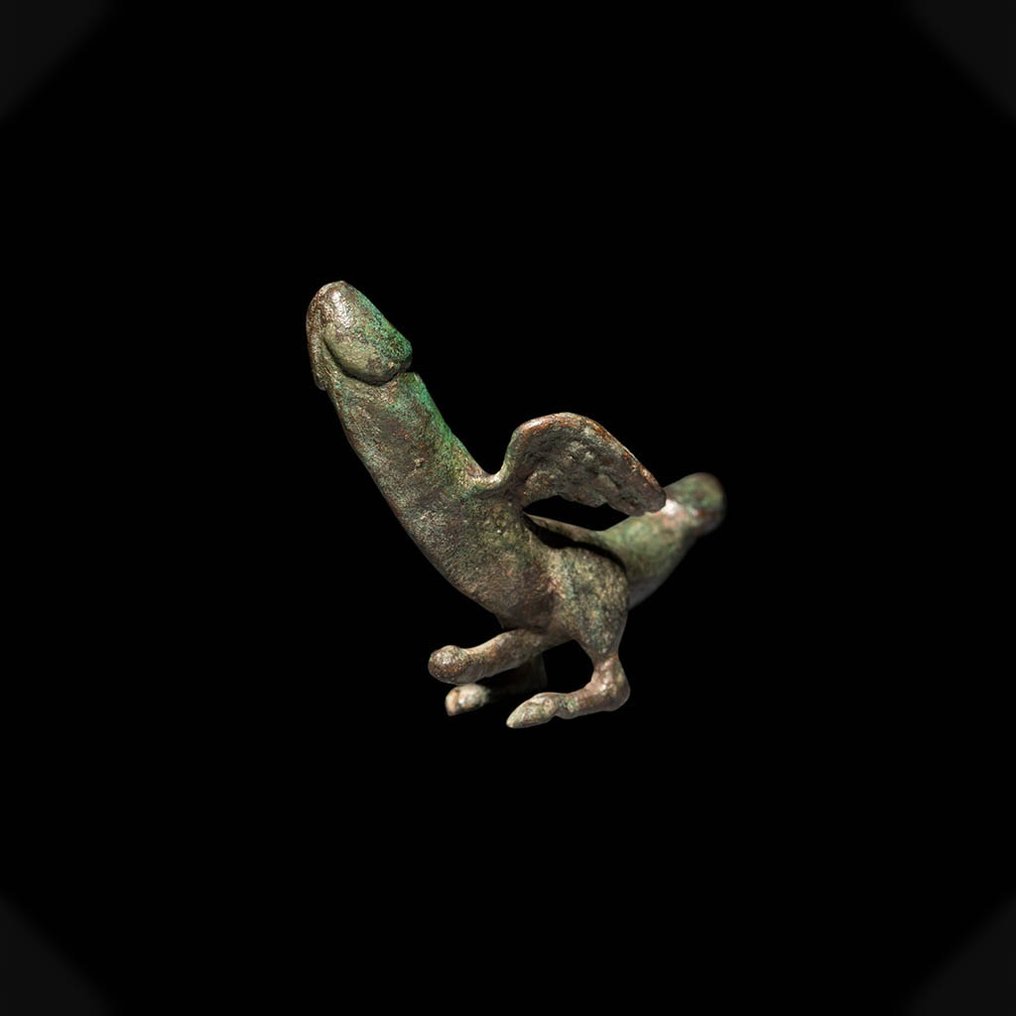a recommander envoi tres rapide est sécurisé embalage tres bien fait vraiment rien a dire plus que parfait
Visualizza traduzioneRoma antica Bronzo Amuleto fallico con ali. I-II secolo d.C. Lunghezza 7,5 cm. Licenza di esportazione spagnola.
N. 89257509



Phallic Amulet with Wings.
Ancient Roman, 1st - 2nd century AD.
MATERIAL: Bronze.
DIMENSIONS: 7.5 cm length.
PROVENANCE: Private collection, Great Britain. Acquired in the 1960s.
CONDITION: Good condition. Intact.
DESCRIPTION:
A triple phallic amulet representing a winged and erect male member, with two zoomorphic feet. At the same time, another smaller phallus can be seen between the lower limbs, and one more on a larger scale toward at the back of the first.
Sometimes named the “phallic bird” or “zoomorphic” phallus, the winged male sexual attribute was an habitual motif in Roman iconography, as it incorporated velocity, power, and rapidity. Numerous amulets of this type have been found throughout the Imperial realm, and helping to fill public and private collections.
This is a motif inherited from the Greek repertoire, as it symbolises the god Priapus, a minor divinity seen always with a permanent erection, an artistic resort with which to allude to the fecundity of nature, to abundance and harvests. At the same time, Priapus also had a role warding off the evil eye and protecting homes from thieves. This is the reason why the erect phallus appears on numerous amulets, oil lamps, statuettes and tintinnabula. The latter, generally made of bronze, were made up of a winged phallus from which wind chimes hung, and they were placed in gardens and porticos with the aim of protecting the property and bringing good fortune to the inmates. Various examples have been recovered from Pompeii, which testifies to the popularity of this fetish among the distinct social classes.
BIBLIOGRAPHY:
- Los bronces romanos en España. 1990. p. 251, figs. 167-169.
- GRANT. Eros in Pompeii, The Erotic Collection of the Museum of Naples. 1997. p. 139.
- JOHNS. Sex or Symbol? Erotic Images of Greece and Rome. 1990. n. 52.
PARALLELS:
Fig. 1. Tintinnabulum, bronze, from Pompeii, Museo Archeologico Nazionale di Napoli, inv. 27835.
Fig. 2. Christie’s, Sale 9050 New York, Ars Amatoria: The Haddad Family Collection of Erotic art, 17/12/1998, lot 68.
Fig. 3. Phallic tintinnabulum, bronze, length 10cm, British Museum n. 1865,1118.208.
Fig. 4. Phallic amulet, 2nd – 3rd century AD, length 5 cm, Museo Arqueológico y Etnológico de Córdoba, CE002885.
Fig. 5. Bronze amulet, 2nd - 3rd century AD, Kinský Palace, Praga, NM-H10 7087.
Notes:
- The piece includes authenticity certificate.
- The piece includes Spanish Export License (Passport for European Union) - If the piece is destined outside the European Union a substitution of the export permit should be requested, can take between 1-2 weeks maximum.
- The seller guarantees that he acquired this piece according to all national and international laws related to the ownership of cultural property. Provenance statement seen by Catawiki.
#ancientolympics
Il venditore si racconta
Phallic Amulet with Wings.
Ancient Roman, 1st - 2nd century AD.
MATERIAL: Bronze.
DIMENSIONS: 7.5 cm length.
PROVENANCE: Private collection, Great Britain. Acquired in the 1960s.
CONDITION: Good condition. Intact.
DESCRIPTION:
A triple phallic amulet representing a winged and erect male member, with two zoomorphic feet. At the same time, another smaller phallus can be seen between the lower limbs, and one more on a larger scale toward at the back of the first.
Sometimes named the “phallic bird” or “zoomorphic” phallus, the winged male sexual attribute was an habitual motif in Roman iconography, as it incorporated velocity, power, and rapidity. Numerous amulets of this type have been found throughout the Imperial realm, and helping to fill public and private collections.
This is a motif inherited from the Greek repertoire, as it symbolises the god Priapus, a minor divinity seen always with a permanent erection, an artistic resort with which to allude to the fecundity of nature, to abundance and harvests. At the same time, Priapus also had a role warding off the evil eye and protecting homes from thieves. This is the reason why the erect phallus appears on numerous amulets, oil lamps, statuettes and tintinnabula. The latter, generally made of bronze, were made up of a winged phallus from which wind chimes hung, and they were placed in gardens and porticos with the aim of protecting the property and bringing good fortune to the inmates. Various examples have been recovered from Pompeii, which testifies to the popularity of this fetish among the distinct social classes.
BIBLIOGRAPHY:
- Los bronces romanos en España. 1990. p. 251, figs. 167-169.
- GRANT. Eros in Pompeii, The Erotic Collection of the Museum of Naples. 1997. p. 139.
- JOHNS. Sex or Symbol? Erotic Images of Greece and Rome. 1990. n. 52.
PARALLELS:
Fig. 1. Tintinnabulum, bronze, from Pompeii, Museo Archeologico Nazionale di Napoli, inv. 27835.
Fig. 2. Christie’s, Sale 9050 New York, Ars Amatoria: The Haddad Family Collection of Erotic art, 17/12/1998, lot 68.
Fig. 3. Phallic tintinnabulum, bronze, length 10cm, British Museum n. 1865,1118.208.
Fig. 4. Phallic amulet, 2nd – 3rd century AD, length 5 cm, Museo Arqueológico y Etnológico de Córdoba, CE002885.
Fig. 5. Bronze amulet, 2nd - 3rd century AD, Kinský Palace, Praga, NM-H10 7087.
Notes:
- The piece includes authenticity certificate.
- The piece includes Spanish Export License (Passport for European Union) - If the piece is destined outside the European Union a substitution of the export permit should be requested, can take between 1-2 weeks maximum.
- The seller guarantees that he acquired this piece according to all national and international laws related to the ownership of cultural property. Provenance statement seen by Catawiki.
#ancientolympics
Il venditore si racconta
- 827
- 9
- 2
Beautiful objects! Extremely fast shipment! I can fully recommend this seller.
Visualizza traduzionewonderful apis!very fast shipping!thanks a lot
Visualizza traduzionepezzo bellissimo, e spedito a tempo record, venditore veloce onesto e preciso, consigliatissimo. Grazie
Visualizza traduzioneAlways a great pleasure !
Visualizza traduzioneEnvíos siempre con cuidado
Visualizza traduzioneBuen vendedor
Visualizza traduzioneObjekte wie abgebildet, das Gefäss sogar noch schöner / unkomplizierter Versand und sehr gut verpackt. Perfekte Transaktion!!
Visualizza traduzionesuperb, as usual
Visualizza traduzioneGreat object, fast delivery
Visualizza traduzioneProfessional seller. Object received s described. Fair price
Visualizza traduzionePagas y no recibes el producto.
Visualizza traduzioneWell packed, fast delivery. Arrived safely, in good condition. Thank you!
Visualizza traduzioneDanke!
Visualizza traduzioneLa pieza se corresponde con la ofertada. Envio perfecto. Con todos los certificados y factura. Un diez de vendedor. Muchas gracias.
Visualizza traduzioneone more nice piece thank you!
Visualizza traduzionebellissimo grazie top 💯💯💯💯💯
Visualizza traduzioneWell packed, very nice little oil lamp, never seen such one before!
Visualizza traduzioneEs ist alles top gelaufen. Mir wurde das Artefakt super verpackt und schnell zugesandt. Vielen Dank
Visualizza traduzionePrompt shipping, great packaging. Thank you very much.
Visualizza traduzioneBien !
Visualizza traduzioneTodo ok ….gracias .
Visualizza traduzioneEnvio rápido y muy correcto, muy bien protegido. Con todos los certificados y documentación. Excelente servicio.
Visualizza traduzioneTrès beaux objets archéologiques. Emballage parfait. Livraison express. Merci beaucoup. Gracias.
Visualizza traduzioneall good.
Visualizza traduzione- 827
- 9
- 2
a recommander envoi tres rapide est sécurisé embalage tres bien fait vraiment rien a dire plus que parfait
Visualizza traduzioneDisclaimer
Il venditore garantisce e può provare che l’oggetto è stato ottenuto legalmente. Il venditore è stato informato da Catawiki di dover fornire la documentazione richiesta dalle leggi e dai regolamenti del suo Paese di residenza. Il venditore garantisce ed è autorizzato a vendere/esportare questo oggetto. Il venditore fornirà all’acquirente tutte le informazioni di provenienza note sull’oggetto. Il venditore garantisce che tutti i permessi necessari sono/saranno predisposti. Il venditore informerà immediatamente l’acquirente di eventuali ritardi nel rilascio di tali permessi.
Il venditore garantisce e può provare che l’oggetto è stato ottenuto legalmente. Il venditore è stato informato da Catawiki di dover fornire la documentazione richiesta dalle leggi e dai regolamenti del suo Paese di residenza. Il venditore garantisce ed è autorizzato a vendere/esportare questo oggetto. Il venditore fornirà all’acquirente tutte le informazioni di provenienza note sull’oggetto. Il venditore garantisce che tutti i permessi necessari sono/saranno predisposti. Il venditore informerà immediatamente l’acquirente di eventuali ritardi nel rilascio di tali permessi.









